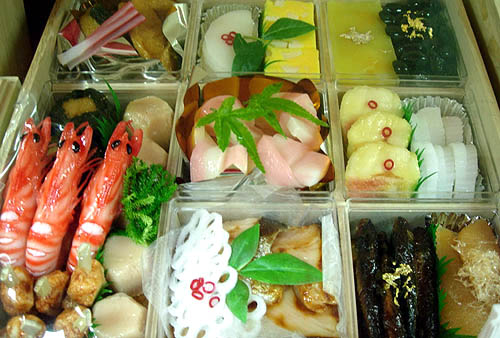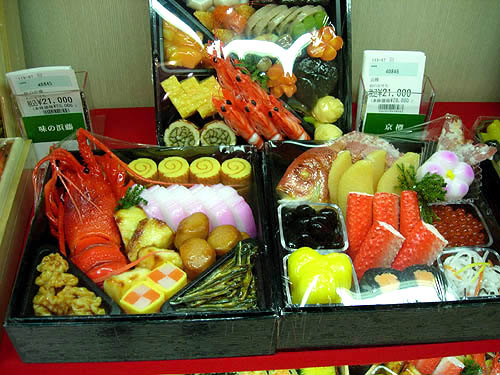Of all the annual holidays in Japan,
the New Year (o-shogatsu) is often spoken of as the "most Japanese" of celebrations. With a history reaching back a thousand years, the traditional New Year's celebration is sprinkled with symbolism, and that symbolism is particularly evident in typical New Year's food.
It’s traditional custom for Japanese people to eat
O-sechi (traditional food for the New Year) and
O-zoni (rice cake and fish based soup) during New Year’s, just as Western people enjoy eating turkey and pumpkin pie on Thanksgiving day.
"Osechi ryori" is what most people in Japan eat at the beginning of the new year. Regardless of how many times you splurge at Nobu, osechi isn't something you'll ever find on a Japanese menu. Its time and place are the first few days in January, in the Japanese home.
Osechi ryori was originally a way for housewives (and their families) to survive the first several days of the New Year, when stores throughout Japan were closed. The foods that make up osechi can be prepared in advance and then sit out in a cool area for a few days without spoiling. Most often everything is placed in compartmentalized lacquer boxes that are stacked in layers.
SECHI originally means celebration. It is a celebration of the new year, and one of the five times a feast is mythically served to the gods.
Many different kinds of dishes (10-30 kinds) are packed in boxes called JUBAKO. The shape, pronunciation, and colour of each ingredient represent good luck, happiness and longevity.
Ingredients of O-sechi »
In the old days, the difference between festive days and normal days were quite distinct.
MOCHI (rice cake) was a food eaten only for celebrations, as was
O-ZONI (rice cake and soup), one of the most important foods in Japan.
Mochi was a food mythically prepared for the gods, and communities often included it in soup. Thus, ozoni was created and each region makes it differently. Whether made with meat or fish based broth, and sweet or savoury, ozoni means good luck. The shape of mochi can be square or round. A round shape portrays a precious mirror from ancient times that has no sharp corners. Everything goes smooth like the rounded lines. If the mochi is square, enemies or bad luck can be beaten with its sharp corners. The former shape is common in Kansai (a region in the south central part of Japan), originating in Kyoto, the old capital of Japan. Usually, the soup is made with white miso.The latter shape is popular in the northern part of Japan, in the Kanto area. This is where the culture of the samurai warrior originated. The picture shows the Kanto area style of ozoni with clear soup.
credit:
http://www.japanesefood101.com/index.php/festive-food-for-the-new-year/happy-japanese-new-year/http://www.bento.com/fexp-osechi.html......................................................................................................................................................
















